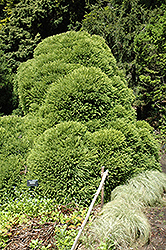It's all about ...
plants

Cristata Japanese Cedar
Cryptomeria japonica 'Cristata'
Height: 30 feet
Spread: 15 feet
Sunlight:
![]()
![]()
Hardiness Zone: 6b
Other Names: Cockscomb Japanese Cedar
Description:
A narrow pyramid shaped evergreen tree with sprays of green foliage that are fused and curved resembling cockscombs; an ideal selection for accent or articulation in the landscape
Ornamental Features
Cristata Japanese Cedar is primarily valued in the landscape for its distinctively pyramidal habit of growth. It has attractive green evergreen foliage. The recurved scale-like sprays of foliage are highly ornamental and remain green throughout the winter. The peeling antique red bark adds an interesting dimension to the landscape.
Landscape Attributes
Cristata Japanese Cedar is an evergreen tree with a strong central leader and a distinctive and refined pyramidal form. Its relatively fine texture sets it apart from other landscape plants with less refined foliage.
This is a relatively low maintenance tree. When pruning is necessary, it is recommended to only trim back the new growth of the current season, other than to remove any dieback. It has no significant negative characteristics.
Cristata Japanese Cedar is recommended for the following landscape applications;
- Accent
- Vertical Accent
Planting & Growing
Cristata Japanese Cedar will grow to be about 30 feet tall at maturity, with a spread of 15 feet. It has a low canopy with a typical clearance of 4 feet from the ground, and should not be planted underneath power lines. It grows at a fast rate, and under ideal conditions can be expected to live for 60 years or more.
This tree does best in full sun to partial shade. It prefers to grow in average to moist conditions, and shouldn't be allowed to dry out. It is particular about its soil conditions, with a strong preference for rich, acidic soils, and is able to handle environmental salt. It is quite intolerant of urban pollution, therefore inner city or urban streetside plantings are best avoided, and will benefit from being planted in a relatively sheltered location. Consider applying a thick mulch around the root zone in winter to protect it in exposed locations or colder microclimates. This is a selected variety of a species not originally from North America.
This plant is not reliably hardy in our region, and certain restrictions may apply; contact the store for more information.
